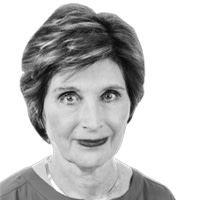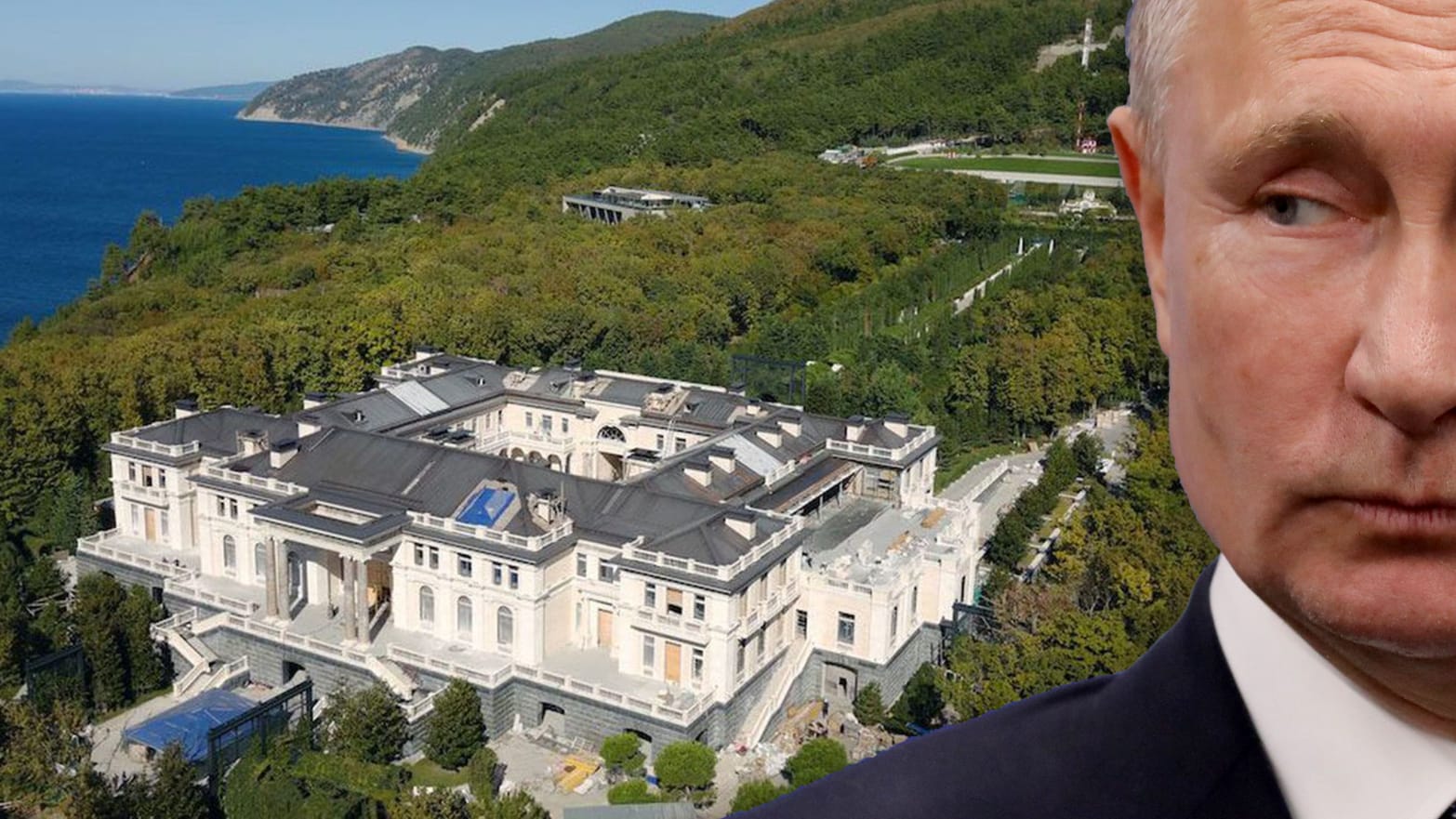President Vladimir Putin has consistently refused to use the name of the recently jailed democracy activist Alexei Navalny, referring to him as a “blogger” or, after his Novichok poisoning and evacuation to Germany, as the “Berlin patient.” Putin even said at his annual press conference in December that the unnamed man was not important enough to warrant being killed. Yet Putin acknowledged on Monday in a virtual meeting with university students that he took time out of his work schedule to watch excerpts from Navalny’s explosive video “Putin’s Palace: A History of the Greatest Bribe,” which documents the construction of one of the world’s most lavish vacation retreats.
It was effectively the first time Putin has acknowledged the importance of Navalny, whose YouTube video has gripped Russia and generated almost 90 million views worldwide.
Unlike the glowing portraits of Putin that are produced regularly by government-controlled Russian television, Putin is presented here as a villainous thief. In Navalny’s words: “Putin is a madman, who is obsessed with money and luxury and literally ready to destroy the country and kill for the sake of his chests of gold.”
In addition to Navalny’s dramatic arrest when he landed back from Germany at Moscow’s Sheremetyevo Airport, this viral video, which charts the construction of a billion-dollar private palace on the Black Sea, inspired protesters to take to the streets by the thousands in cities all over Russia at the weekend. It is no wonder Putin carved out some time to have a look.
And yet, he claims the video was a “boring” compilation.
“Nothing that is listed there as my property belongs to me or my close relatives, and it never did,” he said, with a straight face.
The Kremlin is finding it increasingly difficult to keep its secrets from stealthy internet investigators, who have used open sources to document the Russian government’s role in such acts as the 2014 downing of Malaysian Airlines Flight 17, the 2018 poisoning of Sergei Skripal and his daughter, and the recent Navalny poisoning. As shocking as those events were, Navalny's revelations about Putin's palace may prove to be the most damaging of all to the Kremlin. The campaigner came to prominence over the years with his social media anti-corruption videos, which call out the twisted economic model of Russia’s oligarchs and kleptocrats, but his latest video—forced into the mainstream by attempts to assassinate its producer—has become his break-out hit.
As Navalny said to his audience, the greed of Putin and his ministers and everyone in his ruling circle is colossal: “They will steal and steal until they ruin the whole country. They will sell oil and gas and metals in huge quantities while the incomes of the people drop further and further.”
Judging from the huge nationwide turnout for protests against Navalny's detention on Sunday, a substantial number of Russians who saw Navalny's film got its message. Putin’s improbable obfuscations are only likely to add to the growing distrust between the president and his people.
The breakthrough symbol of greed is a lavish palace near Gelendzhik on the Black Sea coast, which is alleged to be owned or controlled by Putin. According to Navalny, whose investigators used drones to photograph the estate, the palace territory is 39 times larger than the principality of Monaco and features an ice palace, an ornate Russian Orthodox church, a huge underground ice hockey rink, extensive vineyards, and an underground tunnel with access to the sea. Navalny used photographs taken secretly by workmen to show viewers the inside of the classic Italian-style palace, which houses a casino, a hookah bar with a pole for dancing, a discotheque, several spa areas, a hair salon, a home cinema, and a gigantic theater. An area around the heavily-guarded property that is leased to the FSB creates a buffer zone, and vessels are barred from entering more than a mile of coastal waters bordering the estate without permission from the FSB.
This is not the first time that reports about this palace have appeared in the Russian media. In 2010, a businessman named Sergei Kolesnikov, who Navalny interviews, wrote an open letter to then-Russian President Dmitry Medvedev, in which he discussed the construction of the palace. Exiled in Estonia, the whistleblower Kolesnikov had co-owned a company called Petromed, which received government contracts for the purchase of medical equipment, with two Putin allies, Nikolai Shamalov and Dmitry Gorelov. According to Kolesnikov and a subsequent investigation by Reuters, $48 million of the funds allocated by the government for medical equipment were siphoned to an off-shore company controlled by Shamalov and Gorelov and used to purchase materials for the construction of “Putin’s palace.”
According to Navalny, in order to divert attention from the scandal caused by Kolesnikov, Putin and his cronies came up with a scheme to set up a puppet owner of the palace, longtime Putin ally and businessman Alexander Ponomarenko, who claimed that he bought the property in 2011 for $350 million. In fact, by going back to property documents, Navalny was able to discover that Ponomarenko paid only around $350,000 for the palace. The transaction was allegedly done to hide the fact that Putin and members of his administration were the actual owners, with employees of the FSB and the Federal Guard Service (FSO) overseeing further work on the site. Meanwhile, construction on the site continued, thanks to generous contributions from state-owned companies Rosneft and Transneft, and from close Putin allies Gennady Timchenko, Yuri Kovalchuk, and cellist Sergei Rodulgin, whose offshore funds were revealed in the Panama Papers.
The Russian website Open Media was able to independently confirm some of Navalny's findings. A small Moscow company called Aerokompleks, which provides airports with ground equipment, reported on its website that its employees have extensive experience in supplying and inspecting such equipment at the helipads of the presidential residences, including “Praskoveyevka.” Praskoveyevka is the village near “Putin's palace” that is mentioned in Navalny's investigation.
Using information from the State Air Traffic Management Corporation, Open Media confirmed that there is a heliport on the territory of the palace and that the site is located inside a special no-fly zone, closed to all aircraft. The Russian Air Transport Agency (Rosaviatsia) registry also revealed that the site, called the “Praskoveyeka Guest House,” belongs to a company called Komplex LLC and is managed by it. Navalny established on the basis of bank documents that the company received a little more than 9 billion rubles from businessmen close to Putin. The helipad has not been functioning since 2019, but two anonymous sources told Open Media that high-ranking visitors reach the residence by sea.
In 2015, Radio Liberty interviewed the Italian architect of the palace, Lanfranco Chirillo, who confirmed Navalny's claims that he owns property nearby and that one of his close neighbors is Tatyana Kuznetsova, the wife of a former high-ranking FSO officer Oleg Kuznetsov, who according to Navalny, has presided over the construction of Putin's palace.
On Russia’s Channel One Sunday night, Putin’s press secretary Dmitry Peskov discussed the Navalny documentary for the fourth time in less than a week. Peskov had obviously studied the film carefully, because, in an effort to show that it was produced in the West, rather than by Navalny and his team, he pointed out examples of what he said were poor translations from English to Russian. Calling the film a “pseudo-investigation” and “pure lies,” concocted in order to “stir things up,” he urged viewers not to “make themselves into idiots” by watching it. But Peskov was forced to admit that the palace existed: “Well, probably there is such a palace in Gelendzhik, everyone says that, indeed, there is a huge object there, and so on. But it has private owners, probably businessmen. If they act within the framework of the law, they are free to own any objects. But what does the president have to do with it?”
It is clearly a big problem for the Kremlin that it cannot provide the public with the name of the owner of the palatial complex, or explain why it is guarded like a fortress by the FSB and the FSO and is protected by air with a no-fly zone. Why does the owner deserve such security, paid for with money from taxpayers? Why was the palace financed—as shown by documents produced by Navalny—by state-owned corporations such as Rosneft and Transneft? Posing these questions, political scientist Vladimir Pastukhov came to this mock conclusion yesterday: “It is logical to assume that a certain ‘third party’ who can use the services of the FSB, FSO, and the Russian Presidential Administration and attract funding from a state company is most likely the bearer of real power in Russia… this would mean that Putin, whom we consider the all-powerful ruler of Russia, is only a nominal president… That is, Putin is either in complete isolation or has been replaced altogether."
Navalny's team are now calling for more demonstrations on Jan. 31, and the Kremlin's only option will be more arrests and other coercive tactics. But whether repression will be a successful long-term strategy to keep the secret owner of the Black Sea palace in power is far from certain.

